MacGregor Yachts, one of the largest builders in the US, has a well-established reputation as the producer of inexpensive boats. Located in Orange County, California, its plant sits across the street from the former headquarters of Westsail and Islander in a neighborhood that in 1973 built more than 24,000 boats with a retail value of $88 million. A year later, the number of boatbuilders shrank from 46 to 22. MacGregor endured by sticking to a business plan that is strong on financial and management principles and devoid of romance.
The company was founded by Roger MacGregor as a hobby following his successful completion of the MBA program at Stanford University, where he graduated Phi Beta Kappa, second in a class of 200; he had previously graduated Phi Beta Kappa with a degree in economics from Occidental College.
MacGregors studies at Stanford produced a business model based on the sailboat industry that he eventually used as the blueprint for the company. In 1964, while employed at Ford Aerospace, he began building boats as a hobby. Wife Lou, who is still active in the business, oversaw the embryonic stages of the company.
In 1967, when I was finally making more money from the hobby than my real job, I moved into boatbuilding full time, he recalled.
Since that modest beginning the company has built more than 37,000 boats in its 65,000-square-foot factory, and has annual sales of $10 million. It employees 150 people.
Initially marketed under the Venture brand, the name was changed to MacGregor in 1977. Though the company focused on 22- to 25-foot fiberglass sloops, it made a foray into the big boat market in the 1980s with the MacGregor 65 ULDB, which MacGregor claims was the most successfully produced big boat in the industry. A decade earlier, MacGregor built a 36′ catamaran.
Unlike many industry doomsayers, MacGregor doesn’t agree that the sailboat market has dried up; he thinks people have lost interest because of a perception that sailing is too complicated. To attract newcomers to the sport, he builds boats that are simple to operate, require little maintenance, and are low-priced. His 28-page owners manual is written in everyday English, and includes basic sailing instructions. He also has recruited a loyal dealer network that understands the product and caters to first-time buyers.
MacGregors strategy is to concentrate the entire production effort on one boat so as to amortize production and tooling costs over a long run.
Over the years we have zeroed in on the 26-footer for a number of reasons. It is the largest boat that can be easily and safely trailered and launched, and economically shipped in containers.
Originally introduced as the 26X, the new model replaced an earlier MacGregor 26, a water-ballasted sloop previously reviewed in PS (November 1, 1987 and August 1, 1995); 7,000 of the first model were produced. Since its introduction in 1995, 4,000 of the new 26s have been built, and the company enjoys a backlog of orders stretching into 2001. MacGregor sees no need to increase production, which currently turns out one boat every two hours.
The Design
The 26X, conceptually similar to the powersailers built by Lancer in the 1980s, represents MacGregors attempt to reach several markets with a boat capable of sailing at 7 knots and powering at 20-plus knots.
From an aesthetic standpoint, the boat gets average marks. Viewed from the bow, with an entry angle of 18, it has a conventional appearance. Viewed from the beam, its high topsides are evident. Freeboard amidships is 3′ 5″.
Unlike the rounded sections of her predecessor, the new model has a flat, straight bottom designed to enhance planing while under sail or power. It also has a harder turn of the bilge, which translates to a higher initial righting moment. Some owners say the boat will carry a genoa in 15-18 knots of wind before reefing the main or shortening the headsail.
The boat displaces 3,750 lbs. with full tanks; the sail area/displacement ratio (SA/D) is 19 and the displacement/length ratio (D/L) is 138, which indicate the potential for speed.
However, MacGregor says, these figures don’t mean much because crew and gear weight is such a big part of the all up weight. He said that every 100 pounds of weight in the boat reduces speed under power by one mile per hour.
Construction
MacGregors theory is that he can sustain his success by eliminating inconsistencies and waste from the production process. Fiberglass fabrics used in the lay-up are cut in patterns and bundled in sequence for laminators.
The hull, deck and interior liners are solid, hand-laid fiberglass, and MacGregor brags that theres not a chopper gun in the factory; instead, workers use low-volume airless guns to wet out resins. No cores are used.
He is particularly rankled by critics who claim his methods are quick and dirty.
We have the neatest, most tightly controlled plant on the earth, and these boats arent failing, he said.
The lamination schedule calls for a layer of 1-oz. mat, followed by 10-oz. cloth, a layer of 1.5-oz. mat, 24-oz. roving, and layers of 1.5-oz. mat and roving. High-load areas in the centerboard trunk and bow have 15 layers of fiberglass built to a thickness of 3/4″; low-load areas are 3/16″-3/8″ thick.
The hull-deck joint is two outward-turning flanges that are secured with stainless steel bolts and locknuts with nylon inserts located on 4″ centers. The joint is bonded with 3M 5200 and the seam is covered with a rubber rail.
The liners are bonded to the hull with 6″ wide strips of mat and roving.
Boats built since spring 1999 have a new deck structure. Older boats have a balsa-cored deck and companionway hatch. The new deck is stiffened by a series of solid fiberglass U-shaped beams with an outer flange bonded to the inside of the deck. The beams, which are on 4″-6″ centers, are filled with foam, over which are laid layers of 1.5-oz. mat; the deck liner is then laid over the deck, which compresses the foam and bonds the deck and liner.
MacGregor said the new method produces a stronger structure and avoids the problems of rot with balsa. The process also reduces weight by 125 lbs.
Water ballast is carried in a chamber that runs from 3′ forward of the transom to the V-berth; it is 4′ wide and acts as a longitudinal stringer. It is enclosed by a fiberglass module bonded to the hull.
This leaves precious little area below the sole for a bilge. Because there is no way to inspect the bilge without looking behind the galley, there is no way of knowing how much water is in it. The company now drills a 1/2″ hole in the sole below the companionway to allow bilge water to appear on the floor of the main cabin.
Without the hole it is possible for the boat to collect a really large, stability-threatening load of bilge water, MacGregor said. Since the liner floor area is essentially a watertight tub, the skipper had no way of knowing until it reached the level of the cutout in the face of the galley.
I prefer a more obvious warning. When he steps in the cabin and ends up with water up to his ankles he will get the message. I recommend owners of older boats make a similar hole, being careful not to drill into the water tank.
One owner said cleaning up bilge water on the sole is messy.
A company video shows that, will full ballast tanks, the boat is self righting. With 120 lbs. of pressure on the jib halyard, the mast lay in the water, and immediately popped upright when the halyard was released; MacGregor said the limit of positive stability is about 115.
MacGregor also claims the boat has positive flotation; the same video shows a boat still floating that is filled with water halfway up the cockpit floor. Flotation is Styrofoam blocks in the cockpit coaming, bow, and under the anchor locker.
As weve written before, water ballast doesn’t produce as stiff a boat as lead, but because you can drain it on the ramp (or dump it underway going 8 knots or faster), you don’t have to tow it down the road.
The centerboard is hollow with drain holes, the bottom of which is filled with resin. It weighs 25 lbs., compared to 600 lbs. in the original 26. The board retracts into the hull, thus avoiding potential damage while launching and loading.
Access to deck hardware and wires is via liner plugs mounted throughout the boat; access to the motor mount and rudder mount are through a hatch in the stern.
The mast is a 7/8 fractional rig with swept-back spreaders and two shrouds; spreaders are mounted in sockets on the mast, an improvement over the original 26. MacGregor constructs the spar from 3″ x 4″ extrusions with wall thicknesses of 1/8″. Standing rigging is 1/8″ 7 x 19 wire on the stays, and 5/32″ 1 x 19 for the shrouds.
Despite criticism that the rigging is too light, MacGregor said, These rigs just don’t come down.
Chainplates are bolted through the hull with stainless steel bolts, washers and nuts. They are strong enough that during construction they are used to remove the hull from the mold;
Deck
The cockpit and deck are typical of boats this size; however, there are no side decks so movement forward is over the cabintop. There are lifelines running from the stern pulpit to the base of the bow pulpit; owners with small children would be well-advised to install safety netting at the bow.
Deck hardware consists of two Lewmar #6 winches and cam cleats for the centerboard and furler lines, vang and halyard, located atop the cabin. The centerboard raises easily from the cockpit.
The helm is a movable seat on the transom behind a steering pedestal; cockpit seats are more than 6′ long, and wide enough to be comfortable for most adults.
Because of its size, the small stainless steel steering wheel looks out of place in the cockpit; however, it is reachable from the helmsmans seat, or the rail.
The mainsheet terminates at a padeye atop a stainless steel pipe inside the pedestal. Though the mainsheet arrangement is convenient to the helmsman, we think a sailor intent on proper sail shape will be frustrated.
MacGregor disagrees. The vang (a $69 option) will control the leech adequately.
The boat is equipped with twin rudders, which improves handling when heeled, and provides space on the transom for up to a 50-hp. motor. The rudders raise easily with ropes cleated on the transom.
The motor is raised electrically from controls on the steering pedestal. One boat we inspected had the cables hidden under a polypropylene strip on the cockpit sole, and on another boat they were led through a hole in the side of the cockpit aft through the stern.
A stainless steel rod attached to the rudders and the front of the motor allows moving them simultaneously.
We were alarmed at the location of the factory-installed stern ladder, which is mounted between the port rudder and the engine, close enough to the engine propeller to be a hazard. Todd McChesney of Bluewater Yachts in Seattle, with whom we sailed, installs a ladder fabricated in Seattle that is mounted outboard of the rudder, a better alternative.
Accommodations
The area belowdecks feels spacious, a reflection of the 90″ beam, lack of bulkheads or visual intrusions, shiny gelcoat surfaces that are devoid of any wood trim, and reasonable headroom. The company advertises standing headroom. We measured 510″ headroom at the foot of the companionway, but theres less amidships.
Accommodations include a king-sized berth below the cockpit, galley and two settees to port, head and dinette to starboard, and V-berth large enough for two adults.
Though the boat is advertised as having sleeping accommodations for six, MacGregor says thats two too many. The aft berth measures 90″ x 78″, and has enough headroom to use the hull as a backrest. The forward V-berth is 76″ wide at the head, and the dinette converts to a double that measures 80″ long and 41″ wide.
Except for a smoked Plexiglas door enclosing the head, the entire area is wide open, so privacy curtains fore and aft would be high on our list of additions.
The dinette is elevated, providing virtually 360 sight lines through fixed ports, forward hatches and the companionway hatch-a good touch. The table, which is nearly 36 inches square, has a clever feature-a clear acrylic insert flush with the surface of the table under which a chart can be placed. The aft dinette seat is 41″ wide and 18″ deep; the forward seat is slightly smaller.
Stowage below the forward seat extends to the V-berth, and stowage for a removable 48-quart ice chest is located below the aft seat.
The head is marginally large enough to allow showering. It is 25″ wide, 40″ long, and has 57″ of headroom. The only furnishings are a molded sink, small storage area, and a mirror on the bulkhead. A porta-potty is equipped with a holding tank.
The galley is quite small. Counter space consists of several 4″ x 5″ ceramic tiles, a molded fiberglass sink with a freshwater faucet, and cutout for an optional two-burner stove. The galley could use more stowage.
The finish of stowage areas isn’t great; we found rough surfaces on the hull as well as fiberglass shards that can produce cuts.
Performance
We tested the boat on a dead calm day so were able to try her agility under power. We had to rely on owner comments for input about sailing characteristics.
Because of its high profile and hull shape, upwind performance is average at best. Most owners opt for a CDI roller furler, a $495 option.
I usually allow 95-105 for a tack, the owner said. Absolute perfect sailing is in 10-15 knots of wind on a close reach. Ive sailed the boat in as much as 35 knots with reduced sail.
Gene Arena, a dealer who has represented MacGregor in San Francisco since 1968, said the boats fare well in the bays gusty, lumpy conditions.
We have to reef this boat sooner than a typical 25′ keel boat, he said, but even novices learn to sail the boat quickly. We typically put the first reef in when wind speed reaches 15-20 knots; when wind speed exceeds 25 knots we tuck in the second reef and reduce the headsail to 65%.
The calculated jib sheeting angle is 11, but Arena said, I don’t think this boat points as well as the old 26 because it has more windage and a different hull shape, so the best bet is to foot off 10.
An owner who sails regularly on San Francisco Bay said, My wife and I sail the boat regularly in 20-knot winds with no problems. With a reef in the main, shes stable and sails well, heeling about 15. But Id never take her into blue water.
Another owner, who sails off the coast of Northern California, said, We typically have 15-20-knot winds, and long 8′-10′ swells, which she handles easily. I think this is an outstanding boat. I was knocked over 50 by a 40-mile per hour gust, and she popped right up and nothing broke.
A Puget Sound sailor, who said he usually sails the boat under shortened sail, records speeds of 8 knots on a broad reach with the genoa. I also like the fact that the bigger motor allows me to fight the heavy current we experience in the Northwest, he said.
The PHRF handicap is between 240 and 250.
MacGregor claims top speed under power exceeds 20 knots, which we confirmed on our test with a boat powered by a 50-hp. outboard. A 9.9-hp. will push the boat at 6-7 knots, a 25-hp. at 12-14 knots. Most buyers opt for the 50-hp. motor. But the added weight of the big outboard has its downside. One owner said, The boat ends up with too much weight aft with 180-230 pounds of motor on the stern, ballast tank, gas tanks, and passengers.
In addition to straight-ahead speeds, we made 360 turns at 18 knots with relative ease and noted that the boat stays relatively flat. In choppy seas, the flat bottom could be expected to pound.
As for its seaworthiness, Roger MacGregor said, The 26 was designed for typical small cruising boat use-inland waters and limited coastal sailing. It is too small to be a long-distance passagemaker. It wont hold enough gear and supplies, and the long-term, day-after-day motion of a small, light sailboat can be tough on the crew.
There are thousands of these boats out there, and many have been caught in, and survived, some really extreme weather conditions, on both lakes and oceans. Like most small cruising sailboats, the 26 can handle high winds and nasty seas, but risk and discomfort levels increase dramatically in severe weather. To maximize fun and safety, most of our owners wisely keep a watchful eye on the weather and try to avoid severe conditions.
Conclusion
Theres no question MacGregor is building an inexpensive product that sells for $4,000-$6,000 less than its primary competitors. The list price for boat, sails and trailer is $14,995 FOB the factory. Genoa and gear, roller furling, cruising spinnaker, vang, mast raising system, stove, cushions and transportation jump the price to $17,000; add $5,000-$7,000 for engine and electronics.
They also enjoy relatively high resale. Two-year-old boats on the market are selling for 85%-90% of their original prices.
The owner of a recent model sums it up well, She is fast enough to be pleasurable, forgiving enough that I can be stupid, balanced enough that I can be lazy.
The two-year warranty covers all parts manufactured by MacGregor.
Contact- MacGregor Yacht Corp., 1631 Placentia, Costa Mesa, CA, 92627; 949/642-6830.


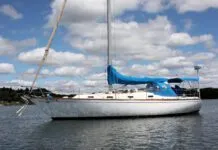

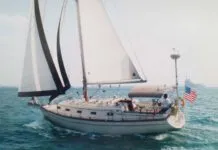
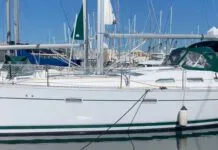
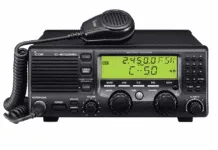



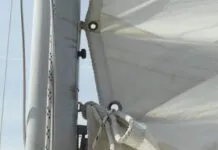

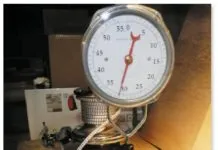







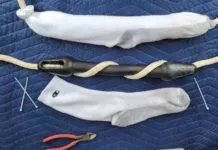










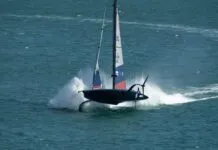
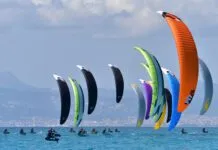





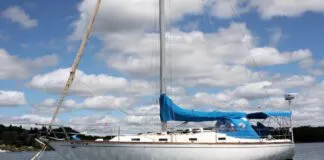
I’d like to add that my MacGregor 26 M has as much room as some 35 footers. I bought it new in 2006 and I will never tire of it! It is the “Jeep” of sailboats, it can float in 12″ of water, and can drive right up on the beach. With a 4-stroke Merc 60 hp, she’ll do 21 mph fully loaded (actually overloaded). She’ll get up on a plane and you’re gone, baby! And at terrific fuel mileage. She sails ok but you won’t win any races, however it wins points being able to sail on a beautiful sunset evening, with nothing but music and no engine noise. She is amazing and people are curious to see how it functions and love it. In Puget Sound the weather changes quickly, but you can get home or back to safe harbor lickity-split, Thank you Roger MacGregor! Mike Jones “Antares”
There is so much information to read I’m wondering if the information to be processed is still relevant. I learn so much about the Mac Gregor 26. This sailboat sounds to amazing to be true in todays market prices. Just starting to to research and there are a lot of older ones out there for sale. Millions dollar question -wait and get new or get old to learn as I go knowing a boat will be more costly so I have to have some throw-away cash on the side